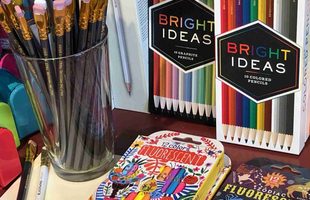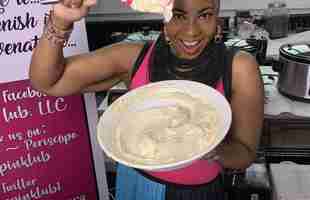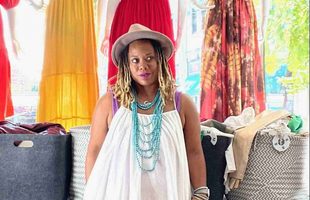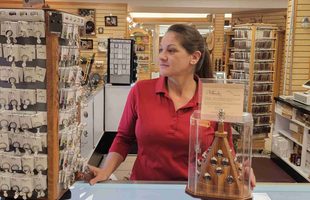What are the best ways to display home decor items in gift stores? According to shop owners and staff, successful display means enhancing the appeal of these items through color combinations, cross-merchandising, and by allowing customers to see how these items will look in the home. Here are some top tips for display and some inside information on best-selling items.
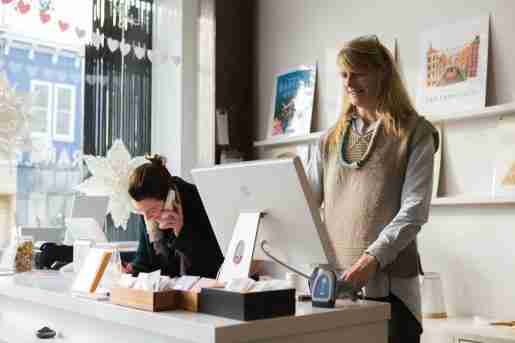 Rachel Robertson, right, and Annie Amundsen, employees at Rare Device. Top sellers at the store are mugs, cups and ring dishes. Photo by Dave Medal.
Rachel Robertson, right, and Annie Amundsen, employees at Rare Device. Top sellers at the store are mugs, cups and ring dishes. Photo by Dave Medal.In the trendy Silver Lake community of Los Angeles, Calif., Michelle Vanderheijden, owner of Mush, does well with vintage home decor in her eclectic 500-square-foot shop. She also sells items on line. “My home decor items are primarily vintage, flea market-type items that are very unique. I keep my prices low. I love to find items that are unusual that I can offer inexpensively,” Vanderheijden noted. She terms vintage pottery and paintings among her best sellers. Along with finding the unusual items she sell, Vanderheijden said that creating attractive displays is one of her favorite parts of being in business. “I’m always moving things around. What inspires me is to look at a piece and I’ll think that it looks good next to another item, I’ll create a story, a little vignette with my groupings, or I will group with color or texture.” She said her primary goal is to create an artistic and appealing display. “I’ll rearrange or tweak items on bookshelves, I’ll put my home decor items next to other items such as books or jewelry,” she explained. Because there is a lot of foot traffic in her neighborhood, she’ll hang paintings outside the store window on the sidewalk, or create inventive window displays. “I’ll put things on social media, on Instagram, too. But I’m old fashioned, I tend to focus on my displays in the store.” There, Vanderheijden said it’s all about creating a flow. “When you come in, the flow guides you to look at more than one item. I want it so that the shop is interesting and unpredictable,” she attested. Her goal is to make people appreciate both the home decor items and “how they are curated.”
Heading north to San Francisco, Calif., Giselle Gyalzen is owner and buyer for the 1,000-square-foot Rare Device, which sells art objects, housewares, and gifts created by local artists and artisans. She said her best-selling home decor items are those that are both “decorative and useful. As an example, my top sellers are things such as mugs or cups, ring dishes, items that can be displayed but also used.” In short: how useful an attractive decor item may be enhances customer interest and her sales.
When it comes to display, Gyalzen cross merchandises her home decor items with other items to shape a story for customers. “I’ll put a mug, some plates, some pretty tea towels all on a table. Or I’ll match a mug with jewelry items. Sometimes we’ll have a color table that tells a color story.” Display technique aside, Gyalzen said, “The most important thing is to keep displays fresh. We change our displays a lot.” Another tip: “We’ll put a decor item in a featured section of the store toward the front at a main table, so that when you walk in, you’ll see the item immediately. We’ll also put home decor items in our window.”
Micano, in Reno, Nev., offers unique steam punk items and hand-crafted art as well as furnishings and home decor in the 1,400-square-foot shop, which also features an outdoor garden area. Owner Sam Sprague said the best technique for displaying home decor items is to set up an area of the store that looks like a room in a home. “We’ll put items on a table in a spot next to the couch so that people can visualize what the decor will look like in their homes. We also have like-products grouped together on upcycled displays that we’ve created.” His top-selling home decor items are lamps. “I think people are looking for a fairly easy way to express themselves, and lamps are small accent pieces that work well for that. Our entire store is art driven, and the lamps reflect that.”
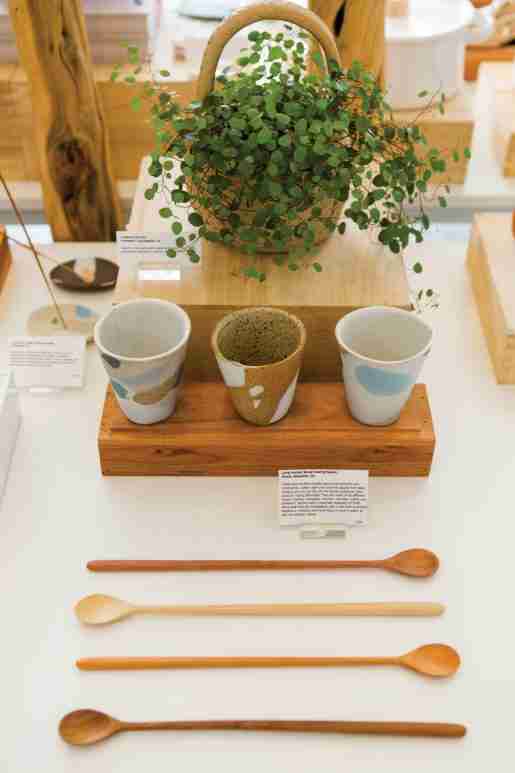 At Rare Device, displays shape a story for the customers. Photo by Dave Medal.
At Rare Device, displays shape a story for the customers. Photo by Dave Medal.In Anchorage, Alaska, at Grass Roots Fair Trade, Owner Liz Dean carries home decor items which, like all of the items in her shop, come with their own story of how they were made, and how they empower the artisans who make them. Her top selling item is a star lantern. “The lanterns do very well for us in part because they are both beautiful and very moderately priced. They’re in the $20 price range. …We have lamps that are beautiful, and they do draw people into the store with the way they look, but they are in a higher price range and don’t sell as well as the lanterns.” Other strong sellers are decorative alpaca throws and blankets.
When it comes to display, Dean tries to mix things up in her 2000-square-foot store. “We will sometimes do color coordination, or we’ll put together a display that provides examples of how an item will look in your home. Overall the most important thing is to keep people on their feet and show items in a different light, change things, keep displays fresh.” She noted that a customer may have seen an item twenty times, but when it is moved to another part of the store or placed in a different display, the customer will notice it as if for the first time. Dean does keep her items within certain categories in the store however, rather than mixing home decor items with another category such as jewelry. She’ll keep home decor for the kitchen with other kitchen items, for example. “We could put a decorative clay pot next to placemats, plates, a trivet,” she explained. “Or we could take a vase and put that in a table setting.”
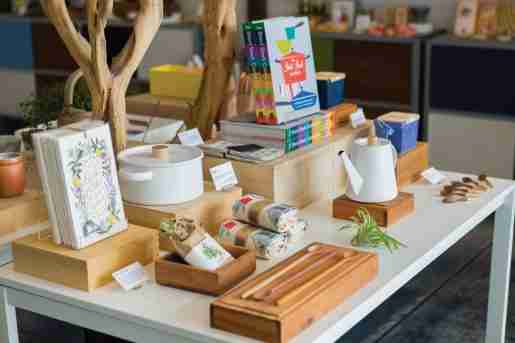 The best-selling merchandise at Rare Device in San Francisco, Calif., is both decorative and useful, according to the owner and buyer. Photo by Dave Medal.
The best-selling merchandise at Rare Device in San Francisco, Calif., is both decorative and useful, according to the owner and buyer. Photo by Dave Medal.In Honolulu, Hawaii, Jill Hatch owns the bright and airy Sugarcane Shop in the Kaimuki district. Hatch sells unique items from bright towels to pineapple swizzle sticks, children’s toys, coffee face scrub, books, calendars, and beach bags. Her Hawaii-themed gifts appeal to locals and tourists alike. And when it comes to home decor items, she has one decisive answer as to her best-seller. “Our pillows definitely do the best, because of the colors and designs. The fact that they are locally made also enhances sales,” Hatch stated. Other strong home decor sellers are lamps and wall hangings. While Hatch cross merchandises some items at the Sugarcane Shop, she keeps her best-selling pillows in one section of her 500-square-foot shop. “I display them in a group. They’re all together, it’s basically a wall of colorful pillows.” According to Hatch, “I think the most important thing in terms of display is to move merchandise around to keep it looking fresh.”
While best-selling home decor items themselves may vary in gift shops, the importance of keeping displays fresh and appealing doesn’t change. Creating a setting that lets customers imagine how decor will look in their own homes, changing the location of displayed items, and telling a story about the items are all key for sales success with home decor.
